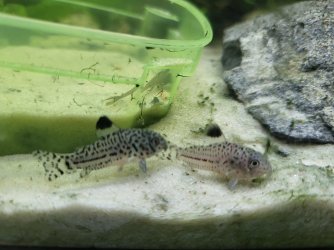CrystalStars
New Member
Hello, again.
I've been having horrible luck with my fish. Lost all my otos, had 10 cories now down to 4, had 2 whiptails now I have 1.
The whiptail was most likely an accidental death from shipping. Its tail was kinked and it didn't recover. The other one is eating and growing big. My problem is the cories.
Most of the cories that died would show red gills, their colour would dull and they would barrelroll in the sand as if they had an itch. Here is one right now suffering from it:


My camera doesn't pick it up well but that lighter one's gills are quite red. I thought it might've been flukes so I quarantined them recently and treated them with paracleanse, then use methlyne blue. When things seemed fine I put them back I into the tank. But this one's gills turned red and it lost its colour.
My parameters are 0 ammonia, 0 nitrite and 0 nitrate. Ph 7.8. Temp is 79. Harness is 120.
I do weekly 25% water changes. I still have cynobacteria that im slowly dealing with. Its not as bad as it used to be but it's still present.
No new fish has been added and I'm not getting anymore until I figure out what's going on. Any help would be much appreciated. I have lost so many fish and it's been extremely disheartening.
I've been having horrible luck with my fish. Lost all my otos, had 10 cories now down to 4, had 2 whiptails now I have 1.
The whiptail was most likely an accidental death from shipping. Its tail was kinked and it didn't recover. The other one is eating and growing big. My problem is the cories.
Most of the cories that died would show red gills, their colour would dull and they would barrelroll in the sand as if they had an itch. Here is one right now suffering from it:
My camera doesn't pick it up well but that lighter one's gills are quite red. I thought it might've been flukes so I quarantined them recently and treated them with paracleanse, then use methlyne blue. When things seemed fine I put them back I into the tank. But this one's gills turned red and it lost its colour.
My parameters are 0 ammonia, 0 nitrite and 0 nitrate. Ph 7.8. Temp is 79. Harness is 120.
I do weekly 25% water changes. I still have cynobacteria that im slowly dealing with. Its not as bad as it used to be but it's still present.
No new fish has been added and I'm not getting anymore until I figure out what's going on. Any help would be much appreciated. I have lost so many fish and it's been extremely disheartening.


